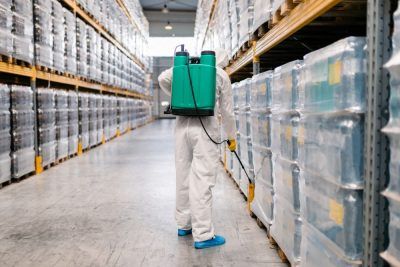Pest management in warehouses is sometimes disregarded. But ensuring a safe and hygienic workplace for staff and stored goods is critical. Pests in a warehouse may cause considerable damage to inventory, product contamination, and even health issues for personnel.
This blog post is written to provide you with detailed information regarding the significance of pest control in warehouses and highlight some of the most prevalent insect types seen in these environments. It also offers a thorough pest control inspection checklist and processes to assist you in preventing and managing pest infestations in your warehouse.
So, let’s get started and find out why pest control is vital in warehouses.
Reasons Why Warehouse Pest Control Is Important
These spaces are meant to hold commodities and products. So, they are a prominent target for pests. Whether rats, insects, or birds, they all can cause considerable damage to inventory, resulting in financial losses. Effective warehouse pest control procedures can assist in protecting your precious stock and avoid infestations that could harm your items.
Moreover, pests not only cause physical harm to products but can also infect them. Insects such as ants, beetles, and moths can infest stored foods, jeopardizing their quality and safety. Keeping your goods pest-free guarantees that it remains intact and meets the high standards that your clients demand.
Furthermore, pests may spread hazardous germs and pathogens throughout your warehouse and carry a variety of diseases. This poses a severe health hazard to your workers who work in or near contaminated regions. You can safeguard your employees from any health dangers with the help of proper pest management in the warehouse.
Typical Warehouse Pests
To effectively battle pests in your warehouse, you must first understand the common pest varieties present in these situations. Here are some pests to be on the lookout for:
⦁ Rodents
Rodents are renowned for gnawing through packaging and contaminating stored items with their droppings and urine. By gnawing on wiring and wooden buildings, they can potentially cause structural damage to your warehouse.
⦁ Insects
Ants, beetles, moths, and cockroaches are just some insects that can infest and destroy your items. Some feed on the products directly, while others contaminate them with droppings and secretions.
⦁ Birds
Birds, such as pigeons and seagulls, can also be a nuisance in warehouses, particularly if they find shelter in the rafters. Their droppings make the area unsanitary, harm your merchandise, and pose health hazards. These are one of the common pests invading commercial properties.
Checklist and Procedures for Warehouse Pest Control
Now that you understand the significance of pest management in the warehouse and are familiar with typical warehouse pests, let’s look at the complete list and processes for efficiently preventing and managing infestations:
1. Exclusion: Bugs know how to make their way to your facility through the tiniest hole. So, never forget to seal all entry points, including cracks in walls, doors, windows, and vents, to prevent pests from entering your warehouse.
2. Sanitation: Keep your warehouse clean in all places. Clean and sanitize floors, walls, and storage racks on a regular basis to eliminate possible food sources like trash and debris for bugs.
3. Waste Disposal: Ensuring correct practices are in place to reduce insect activity in areas where waste collects is critical. Properly manage and dispose of waste. Keep trash bins tightly sealed and remove garbage regularly to prevent attracting pests.
4. Routine Inspection: Inspect your warehouse regularly to check for any indicators of pests or potential entrance points. Address any concerns that develop as soon as possible. In this way, you can control the infestation before it gets too much to handle.
5. Exterior Modification: Taking care of exteriors is as important. Trim back vegetation and remove debris or standing water outside your warehouse since these might attract pests.
6. Product Quality Control: Implement stringent quality control techniques to detect and eliminate infected or damaged items from your inventory as soon as possible.
7. Implementing Integrated Pest Management Solutions: If things get out of your control, don’t hesitate to call a professional pest control company specializing in warehouse pest control. They can also assist you in developing a customized pest control strategy for the future that fits your individual requirements.
8. Pest Awareness for Your Staff: Educate your personnel on the necessity of pest control and give them the knowledge and tools they need to recognize and report any symptoms of infestations.
Warehouse pest management is critical for protecting inventory, ensuring product quality, and preventing health issues. You can establish a pest-free workplace that supports the safety and well-being of your employees by executing a complete warehouse pest control program.
Moreover, pest control is instrumental in protecting the integrity of your stored goods. Remember to prepare a practical pest control inspection checklist that includes exclusion, sanitation, frequent inspections, and staff education. Don’t allow bugs to take over your warehouse; take preventative actions immediately.









 The 2024 virtual Men’s Round Table will be held Q4, 2024, date TBD.
The 2024 virtual Men’s Round Table will be held Q4, 2024, date TBD.













